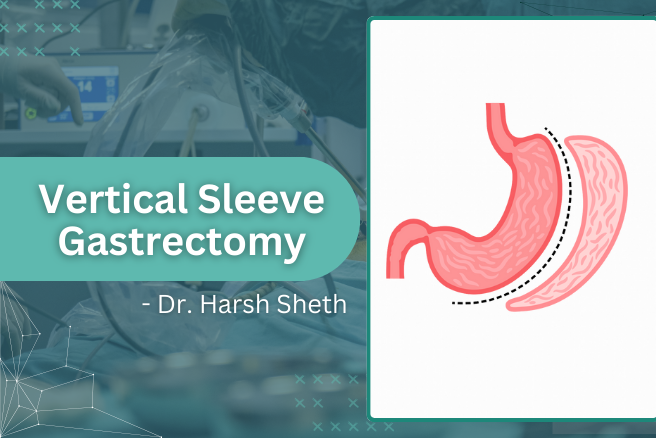Weight loss surgery has revolutionized how we approach obesity and its related health conditions. One of the most popular surgical options is gastrectomy, a procedure where a part of the stomach is removed to limit food intake and aid in weight reduction. Among the different types, Vertical Sleeve Gastrectomy (VSG) stands out for its effectiveness, safety, and relatively simple procedure.

“As a surgeon, I’ve witnessed firsthand how sleeve gastrectomy transforms lives—not just physically, but emotionally. It’s not just about eating less, it’s about regaining control and confidence,” shares Dr. Harsh Sheth.
Dr. Harsh Sheth is a highly skilled bariatric surgeon in Mumbai, with specialization in minimally invasive procedures. With more than a decade of practice and several patents for medical devices to his credit, Dr. Sheth strives to help patients realize their health aspirations safely and efficiently. His warm, empathetic approach and unwavering dedication have made him a sought-after name in the field of bariatric care.
In this blog, we’ll take a look at what VSG is, what to anticipate before and after, and how it will improve your life.
Curious about what happens during the procedure? Let’s walk you through the surgery step by step.
What happens to the stomach during a sleeve gastrectomy?

Vertical sleeve gastrectomy is a restrictive weight loss surgery that alters the size and structure of your stomach. Here’s how:
- Stomach Reduction: About 75-80% of the stomach is removed. The remaining portion is a slender, tube-like “sleeve.”
- Shape and Capacity: The new stomach can contain much less food—about 100 to 150 ml—and make you feel full sooner and longer.
- Hormonal Impact: The part of the stomach responsible for producing ghrelin (the “hunger hormone”) is eliminated, which reduces appetite quite a lot.

“Patients find it amazing how hunger and cravings are reduced after surgery. It’s not only mechanical; it’s hormonal, also,” says Dr. Sheth.
Now that you understand what happens during surgery, let’s explore what comes after.
What should I eat and avoid after vertical sleeve surgery?

Phase 1: Clear Liquids (First few days)
- Water, broth, unsweetened clear juices
- Avoid caffeine, carbonated drinks, and sugar
Phase 2: Full Liquids (1-2 weeks post-op)
- Protein shakes, milk, smooth soups, yogurt
- Continue avoiding sugary or fizzy beverages
Phase 3: Pureed Foods (Weeks 3-4)
- Blended lean proteins, vegetables, fruits
- Small, frequent meals
Phase 4: Soft Foods (Week 5)
- Eggs, cooked veggies, fish, tender meats
- Introduce one food at a time to check tolerance
Phase 5: Regular Foods (After 6-8 weeks)
- Focus on lean proteins, whole grains, and vegetables
- Avoid fried, high-sugar, and processed foods
Some other dietary recommendations are:
- Eat slowly and chew well
- Stop eating when feeling full to avoid overeating
- Drink plenty of fluids but not 30 minutes prior to and following meals
“Nutrition is also a major factor after surgery. Properly planned eating is your ultimate long-term weight loss buddy,” advises Dr. Sheth.
You’ve learned what to eat, but what about how to live?
Are there any long-term lifestyle changes required after the procedure?

- Ongoing Dietary Discipline
Even after recovery, it’s essential to:
- Prioritize protein
- Avoid empty calories
- Maintain portion control
- Daily Physical Activity
- Start with light walking, gradually increasing intensity
- Aim for 30 minutes of exercise most days of the week
- Helps maintain weight loss and boosts mood
- Mental and Emotional Wellness
- Attend support groups
- Seek therapy for emotional eating
- Monitor mood and triggers
- Supplementation
- Due to decreased intake, deficiencies are possible
- Take multivitamins, iron, B12, calcium, and vitamin D daily
- Follow-Up Regularly
- Regular blood work and consultations with the surgeon
- Track weight trends, nutritional levels, and mental health
“Sleeve gastrectomy gives you the tool, but it’s the consistent lifestyle changes that make the difference,” notes Dr. Sheth.
Conclusion
Vertical Sleeve Gastrectomy is a life-changing procedure that reduces the stomach’s size, promotes hormonal changes, and supports lasting weight loss. It’s ideal for individuals struggling with obesity who haven’t seen results with diet and exercise alone.
With Dr. Harsh Sheth, an eminent GI laparoscopic and bariatric surgeon in Mumbai, you can rest assured that your journey will be handled with expertise and compassion. His focus on patient safety, evidence-based care, and individualized treatment makes him one of the most trusted names in the field.
While the road requires dedication and adjustment, the results can be transformative, improving not just your weight, but your quality of life, self-esteem, and long-term health.
Got questions? Let’s answer the ones people ask the most.
Frequently Asked Questions
What is the difference between vertical sleeve gastrectomy vs gastric sleeve?
How much weight can I lose after vertical sleeve gastrectomy?
Is the procedure reversible?
How long is the recovery period?
Will I need to take vitamins forever?
Can the stomach stretch out again after surgery?
What are the risks of the surgery?
What if I don’t lose enough weight?
Will I feel hungry after surgery?
How does vertical sleeve gastrectomy compare to other bariatric procedures?
Disclaimer: The information shared in this content is for educational purposes and not for promotional use.

